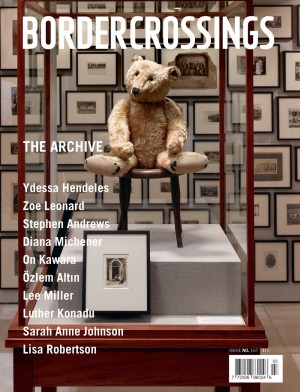Godly Growth and Mystery
The Gateway Theatre Photographic Gallery is a somewhat obscure place in which to show an impressive body of work. Its almost incidental setting stimulates all kinds of questions about the politics of curation, the vagaries of institutional validation, and the current critical privileging of Jeff Wall-style studio photography over photo-documentary forms and traditions.
Located in Richmond, a 45-minute bus ride from downtown Vancouver, the gallery consists of a small room and corridor off the lobby of a municipal theatre. When I was there, auditions were being held in an adjacent studio. Anxious musical theatre types tripped back and forth through the gallery, singing snatches of song, reciting lines, asking anxious questions—and occasionally distracting themselves by looking at the framed photographs on the walls. I couldn’t help thinking that these works deserved a more attentive reading. Quite apart from their amazing technical accomplishment, the toned silver gelatin prints of ancient Maya cities and ceremonial sites projected the wonder of an alien cultural encounter amidst the forest-deep silence of centuries, and evoked a powerful sense of mystery and antiquity.
Vancouver photographer Gerry Schallié has titled his body of work “Pan paxil,” a phrase drawn from a Maya holy book and translated as “broken place.” In the context of these photographs, the title suggests both mythological Maya beginnings and the remaining ruins of ancient Maya culture. Schallié has set himself the project of documenting what may have been, at its zenith, “the world’s second largest urban society.” In this undertaking (begun in 1991 and ongoing) he has taken as his model the 19th-century travelogues of writer John L. Stephens and artist Frederick Catherwood. The record of their 1839-1841 journey through Central America, Chiapas and the Yucatán in search of the “lost” Maya civilization is exemplary, says Schallié, in its descriptive detail and keen observations and its refusal to impose theories of origins or make connection with Old World cultures.

Gerry Schallié, Storm Over El Ray, from “Pan paxil”, c1992, silver gelatin print.
Schallié’s own travels through Mexico, Belize and Guatemala have yielded intentionally archaic images of ruins overgrown with—or reclaimed from—the insistent jungle. (The “jungle” of the Yucatán peninsula is quite different from the rain forest of other Central American sites and not at all what first-time visitors expect. Low and scrubby, it consists primarily of slender, small-leafed, deciduous trees and many varieties of scruffy palms amidst a tumult of brush.) Schallié replicates the look of archival photographs by employing infrared black and white film and printing on a silver-rich paper. The effects of “blooming” and halation, the diffusion of light and the softening of detail, the gentle merging of foreground and background, stand in concerted opposition to the crisp, almost clinical articulation realized by contemporary photographic technologies. The intention here (and it is well realized) is to preserve the impression of an outsider encountering the remnants of a great and mysterious civilization about which much can be sensed but little can be rationally known.
The infrared film, Schallié explains, “throws a lot of emphasis on the stone and trees” at these ancient sites. Architectural and sculptural features, carved in limestone, take on a vivid yet ghostly presence, and the trees stand as if irradiated by some supernatural fission or fusion, some numinous explosion of light, time and space. These trees—some growing out of carved stone steps, some straddling crumbling walls and embankments, some standing on top of temple platforms—are as much a presence in Schallié’s photographs as the ancient Maya structures. Even at those sites that have been cleared of jungle growth, palms, century plants, ceibas (sacred to the Maya) and breadnut trees loom in the near background. Incongruously, a European sense of the pastoral is conveyed in images like El Observatorio, Mayapan and Temple Base, Oxkentok, where well-tended trees and short grass create an almost parklike setting for the “picturesque” ruins. In other images—most notably, Revealed! Temple at La Milpa—the dense jungle growth has only recently been hacked back with machetes, revealing the grassy slope of what may be a temple wall. Of what may, at any moment, be cloaked again in godly growth and mystery. ♦
“Pan paxil,” by Gerry Schallie, Gateway Theatre Photography Gallery (an extension of the Richmond Art Gallery), May 9 to June 5, 1995, Richmond, British Columbia.
Robin Laurence is Border Crossings’s Contributing Editor in Vancouver.

